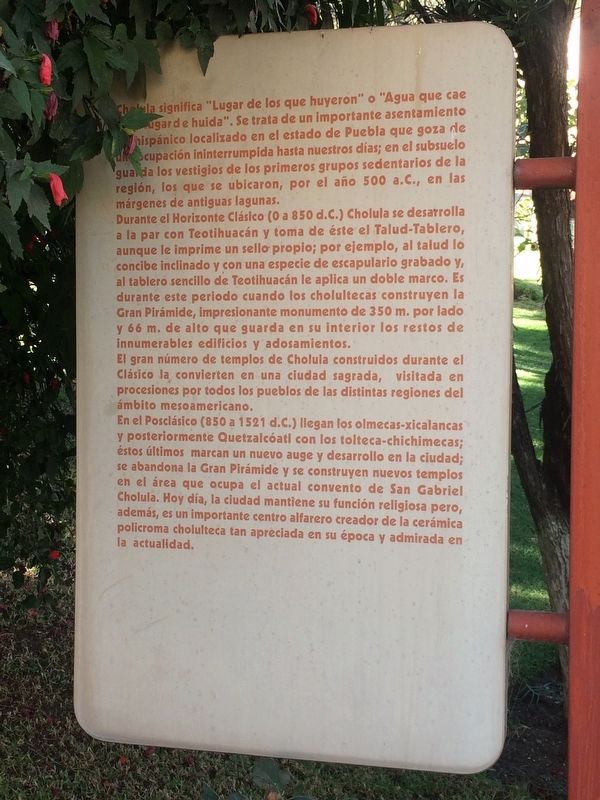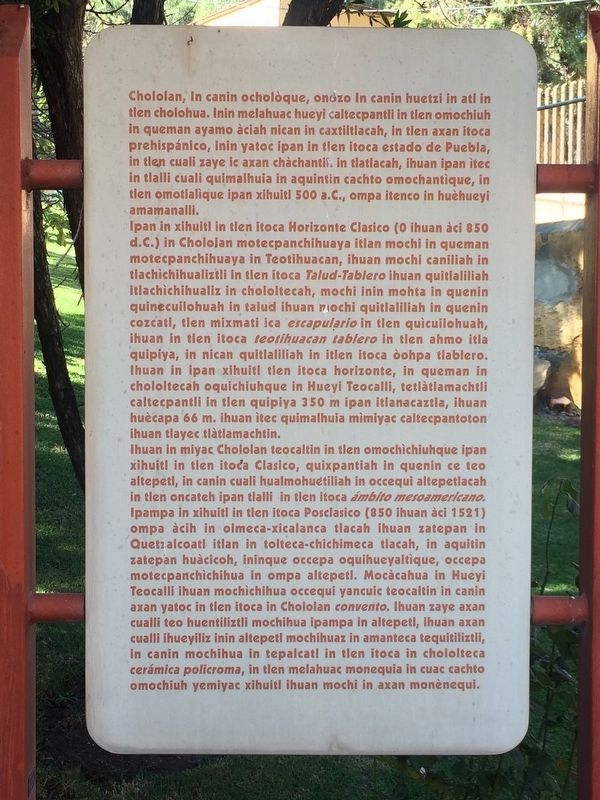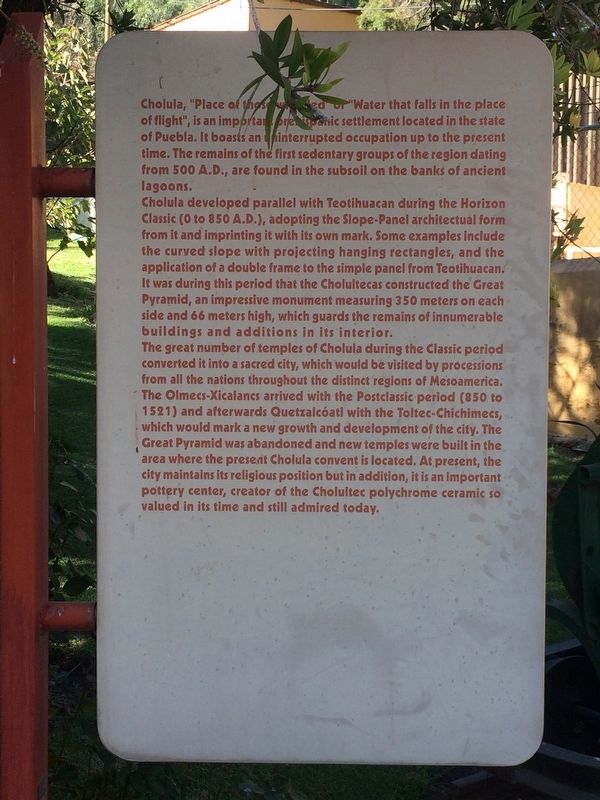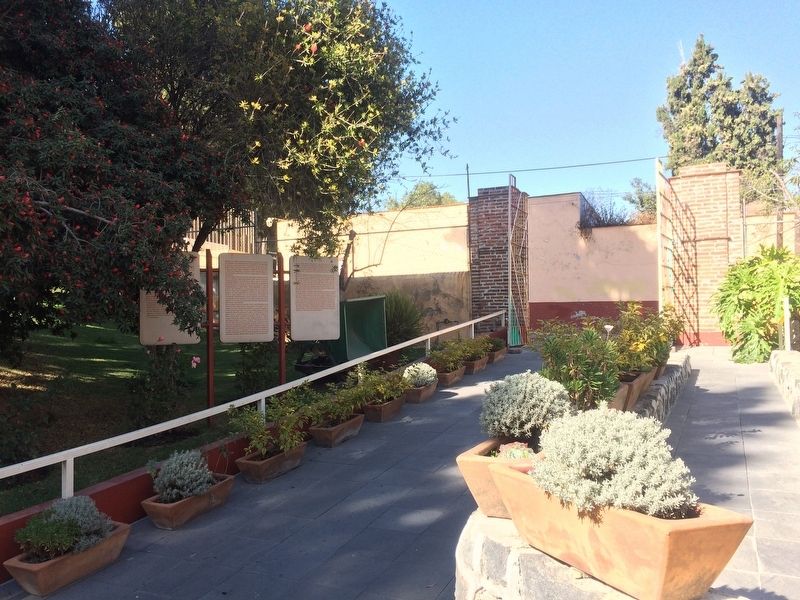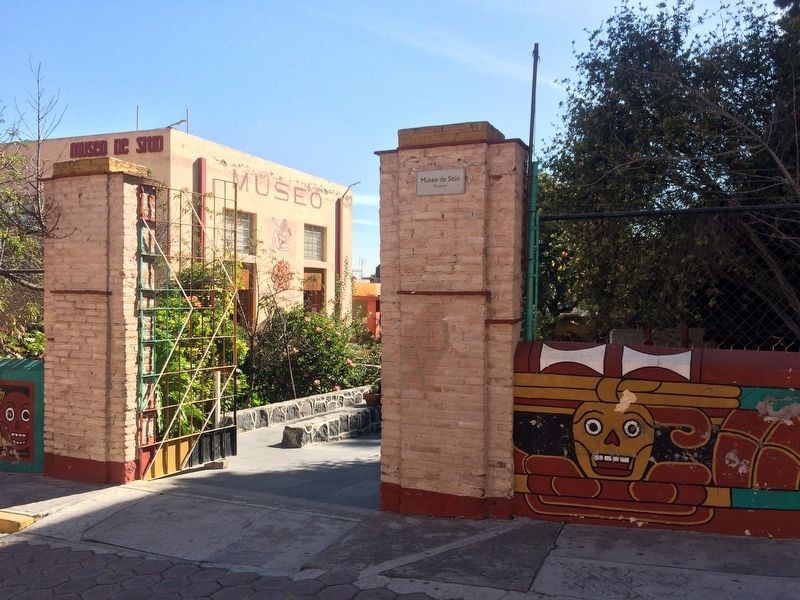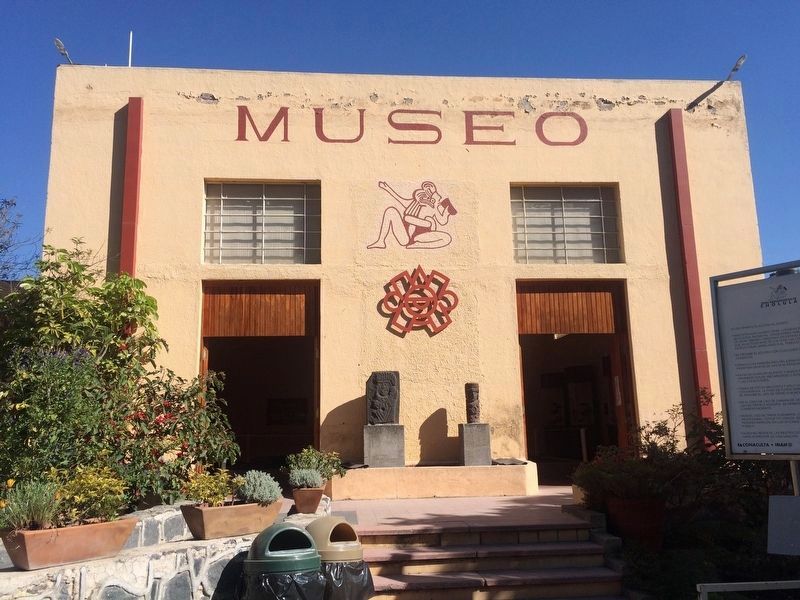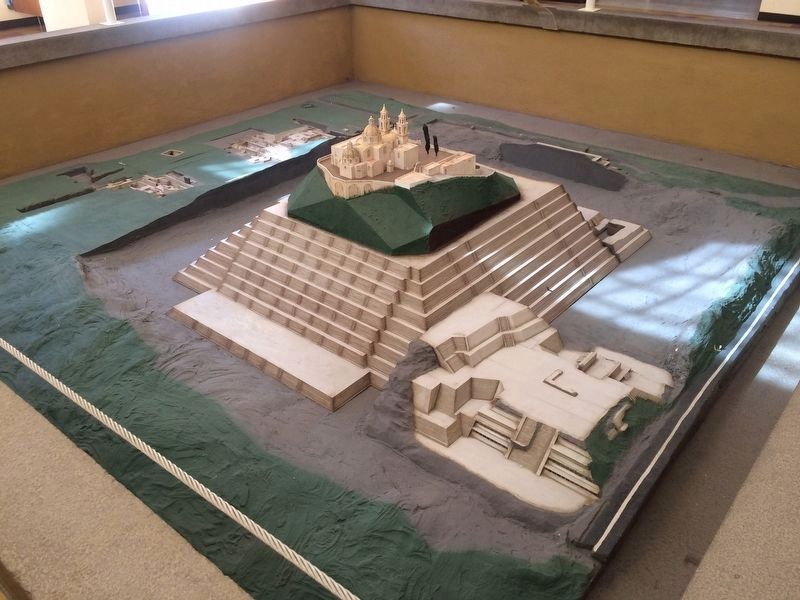San Pedro Cholula, Puebla, Mexico — The Central Highlands (North America)
Cholula
Cholula significa "Lugar de los que huyeron" o "Agua que cae en un lugar de huida". Se trata de un importante asentamiento prehispánico localizado en el estado de Puebla que goza de una ocupación ininterrumpida hasta nuestros días; en el subsuelo guarda los vestigios de los primeros grupos sedentarios de la región, los que se ubicaron, por el año 500 a.c., en las margenes de antiguas lagunas.
Durante el Horizonte Clásico (0 a 850 d.С.) Cholula se desarrolla a la par con Teotihuacán y toma de éste el Talud-Tablero aunque le imprime un sello propio; por ejemplo, al talud lo concibe inclinado y con una especie de escapulario grabado y, aI tablero sencillo de Teotihuacán le aplica un doble marco. Es durante este periodo cuando los cholultecas construyen la Gran Pirámide, impresionante monumento de 350 m. por lado y 66 m. de alto que guarda en su interior los restos de innumerables edificios y adosamientos.
El gran número de templos de Cholula construidos durante el Clásico la convierten en una ciudad sagrada, visitada en procesiones por todos los pueblos de las distintas regiones del ámbito mesoamericano.
En el Posclásico (850 a 1521 d.С.) llegan los olmecas-xicalancas y posteriormente Quetzalcóatl con los tolteca-chichimecas; éstos últimos marcan un nuevo auge y desarrollo en la ciudad; se abandona la Gran Pirámide y se construyen nuevos templos en el área que ocupa el actual convento de San Gabriel Cholula. Hoy día, la ciudad mantiene su función religiosa pero, además, es un importante centro alfarero creador de la cerámica policroma cholulteca tan apreciada en su época y admirada en la actualidad.
Náhuatl:
Chololan, In canin ocholòque, onozo In canin huetzi in atl in tlen cholohua. Inin melahuac hueyi caltecpantli in tlen omochiuh in queman ayamo àciah nican in caxtiltlacah, in tlen axan itoca prehispánico, inin yatoc ipan in tlen itoca estado de Puebla, in tlen cuali zaye ic axan chàchanti in tlatlacah, ihuan ipan ìtec in tlalli cuali quimalhuia in aquintin cachto omochantìque, in tlen omotlalìque ipan xihuitl 500 a.С., ompa itenco in huèhueyi amamanalli.
Ipan in xihuitl in tlen itoca Horizonte Clasico (0 ihuan àci 850 d.C.) in Chololan motecpanchihuaya itlan mochi in queman motecpanchihuaya in Teotihuacan, ihuan mochi caniliah in tlachìchihualiztli in tlen itoca Talud-Tablero ihuan quitlaliliah itlachìchihualiz in chololtecah, mochi inin mohta in quenin quinecuilohuah in talud ihuan mochi quitlaliliah in quenin cozcatl, tlen mixmati ica escapulario in tlen quìcuilohuah, ihuan in tlen itoca teotihuacan tablero in tlen ahmo itla quipiya, in nican quitlaliliah in itlen itoca òohpa tlablero. lhuan in ipan xihuitl tlen itoca horizonte, in queman in chololtecah oquichiuhque in Hueyi Teocalli, tetlàtlamachtli caltecpantli in tlen quipiya 350 m ipan itlanacaztla, ihuan huècapa 66 m. ihuan ìtec quimalhuia mìmiyac caltecpantoton ihuan tlayec tlàtlamachtin.
Ihuan in miyac Chololan teocaltin in tlen omochìchiuhque ipan xihuitl in tlen itoca Clasico, quixpantiah in quenin ce teo altepetl, in canin cuali hualmohuetiliah in occequi altepetlacah in tlen oncateh ipan tlalli in tlen itoca ámbito mesoamericano. Ipampa in xihuiti in tlen itoca Posclasico (850 ihuan àci 1521) ompa àcih in olmeca-xicalanca tlacah ihuan zatepan in Quetialcoatl itlan in tolteca-chichimeca tlacah, in aquitin zatepan huàcicoh, ininque occepa oquihueyaltìque, occepa motecpanchìchihua in ompa altepetl. Mocàcahua in Hueyi Teocalli ihuan mochìchihua occequi yancuic teocaltin in canin axan yatoc in tlen itoca in Chololan convent. lhuan zaye axan cualli teo huentiliztli mochihua ipampa in altepetl, ihuan axan cualli ihueyiliz inin altepetl mochihuaz in amanteca tequitiliztli, in canin mochihua in tepalcatl in tlen itoca in chololteca cerámica policroma, in tlen melahuac monequia in cuac cachto omochiuh yemiyac xihuitl ihuan mochi in axan monènequi.
English:
Cholula, “Place of those who fled” or “Water that falls in the place of flight”, is an important prehispanic settlement located in the state of Puebla. It boasts an uninterrupted occupation up to the present time. The remains of the first sedentary groups of the region dating from 500 A.D., are found in the subsoil on the banks of ancient lagoons.
Cholula developed parallel with Teotihuacan during the Horizon Classic (0 to 850 A.D.), adopting the Slope-Panel architectural form from it and imprinting it with its own mark. Some examples include the curved slope with projecting hanging rectangles, and the application of a double frame to the simple panel from Teotihuacan. It was during this period that the Cholultecas constructed the Great Pyramid, an impressive monument measuring 350 meters on each side and 66 meters high, which guards the remains of innumerable buildings and additions in its interior.
The great number of temples of Cholula during the Classic period converted it into a sacred city, which would be visited by processions from all the nations throughout the distinct regions of Mesoamerica. The Olmecs-Xicalanes arrived with the Postclassic period (850 to 1521) and afterwards Quetzalcóatl with the Toltec-Chichimecs which would mark a new growth and development of the city. The Great Pyramid was abandoned and new temples were built in the area where the present Cholula convent is located. At present, the city maintains its religious position but in addition, it is an important
pottery center, creator of the Cholultec polychrome ceramic so valued in its time and still admired today.
Topics. This historical marker is listed in these topic lists: Anthropology & Archaeology • Architecture • Native Americans. A significant historical year for this entry is 1521.
Location. 19° 3.575′ N, 98° 18.051′ W. Marker is in San Pedro Cholula, Puebla. Marker is on Calle 8 Norte just north of Calle 14 Poniente, on the right when traveling north. Access to the museum and marker is pedestrian only, parking is only available on the street or in nearby lots. Touch for map. Marker is in this post office area: San Pedro Cholula PUE 72750, Mexico. Touch for directions.
Other nearby markers. At least 8 other markers are within walking distance of this marker. Sanctuary of The Remedies (about 210 meters away, measured in a direct line); The Wishing Well of Cholula (approx. 0.3 kilometers away); Dr. Moisés Toxqui Avila (approx. 0.4 kilometers away); Franciscan Convent of The Archangel Gabriel / San Pedro Cholula (approx. half a kilometer away); Dr. Alfredo Toxqui Fernández de Lara (approx. 0.6 kilometers away); Bernardino Rivadavia (approx. 0.6 kilometers away); Emiliano Zapata (approx. 0.6 kilometers away); Parish of San Pedro Apostle (approx. 0.7 kilometers away). Touch for a list and map of all markers in San Pedro Cholula.
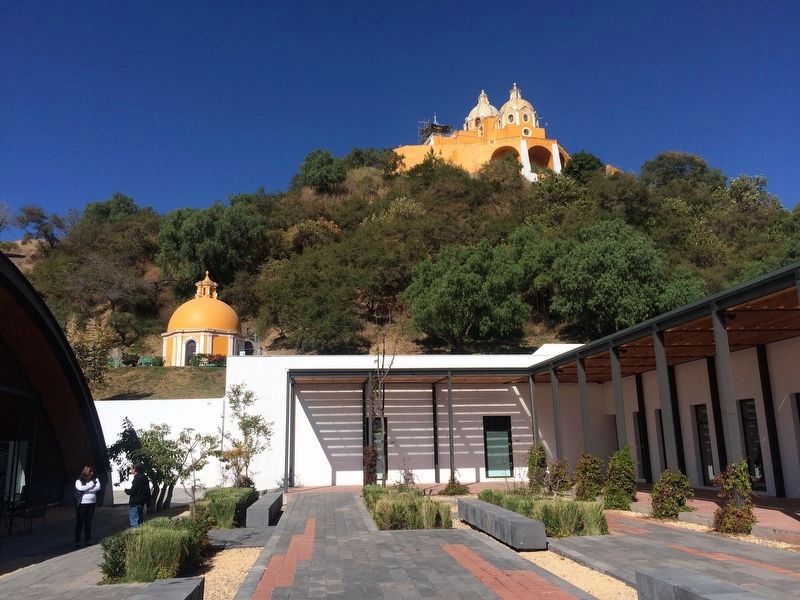
Photographed By J. Makali Bruton, December 1, 2017
7. The Great Pyramid of Cholula
The Great Pyramid of Cholula can be seen here in the distance, topped with the Sanctuary of The Remedies. To the untrained eye it appears to be a small hill, as most of the pyramid's facing stones have been removed or have fallen over time. This view is from the east of the pyramid from the grounds of the Regional Museum of Cholula. The small domed structure to the left is the Wishing Well (El Pocito de los Deseos).
Credits. This page was last revised on March 24, 2024. It was originally submitted on December 10, 2017, by J. Makali Bruton of Accra, Ghana. This page has been viewed 182 times since then and 13 times this year. Photos: 1, 2, 3, 4, 5, 6, 7, 8, 9. submitted on December 10, 2017, by J. Makali Bruton of Accra, Ghana.
